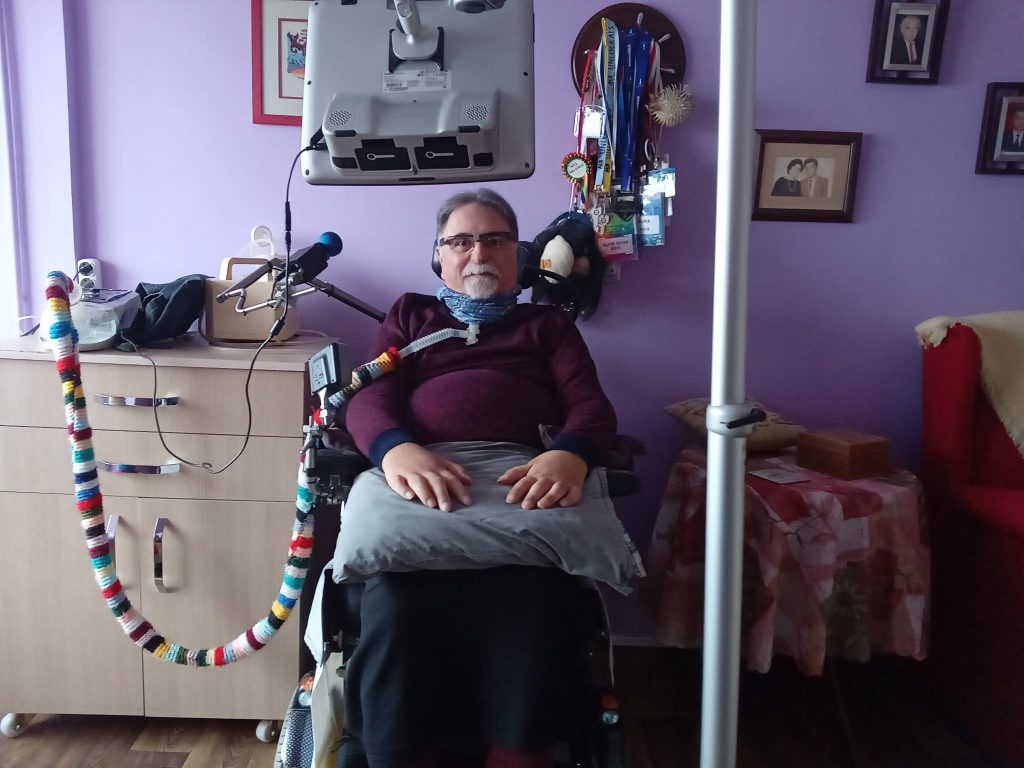For Dr. Alper Kaya, the darkest days of his life happened about 10 years after he found out he had ALS.
Based in Turkey, the ophthalmologist felt fortunate in that the disease progressed slowly, after the initial diagnosis of Amyotrophic Lateral Sclerosis in 1990. He could still perform surgeries, help patients and play classical guitar – one of the constants in his life, ever since he was a teenager.
After about a decade, he lost the use of his hands to do those things he loved. He lost hope, too. At the time, it felt unbearable.
But with the help of his daughter, he found other ways to make music again. Assistive technology gave him the ability to blow into a MIDI wind controller (“a hands-free electronic, breath-powered instrument”). Later, when he couldn’t close his mouth, he found other music-based software to respond to eye tracking and small head movements. He’s got a YouTube channel where he’s uploaded some of his compositions.

Most recently, he was an early tester for DuoRhythmo, a Windows app that recently released its first major update. It enables anyone, including people living with disabilities, to create music collaboratively and remotely in real-time. With it, he can create original rhythms and beats using his eyes.
“Communicating through music is very important for me,” says Kaya, 61. He played in bands throughout his younger days. During high school, university and medical school, he never left music. “Music represents the color of my spirit and when I make music, it develops my spiritual life. I feel free and more creative. If you want to make music, you need an instrument and you bond with it. It’s a special relationship.”
While he can no longer play instruments the way he used to, technology has given him another way to be creative and connect to music.
He immediately liked the DuoRhythmo interface and being able to play hand drums (with his eyes), something he hadn’t done before, and found it very easy for a beginner like him to incorporate the irregular rhythms he grew up with in Turkish music.

What Kaya can do with the app is the culmination of years of research by students at Aalborg University Copenhagen who are studying Medialogy, a major that explores how people interact with computers. That field includes technology such as desktop apps like DuoRhythmo, as well as virtual and augmented reality.
“We really like this concept of extreme constraint design, when you have a very specific target group who have limited ways of interacting with the product. And then instead of making a product and then making it accessible afterwards, we build it from the bottom up to make sure interaction comes first and then everything else comes after,” says Truls Bendik Tjemsland, one of the core group members who created the app — students who are in the master’s leg of the Medialogy program, scheduled to graduate in summer 2023.
As they were looking for projects to work on, music emerged as the focus because of its creative and collaborative nature, a means to connect people and bring them together. A collaboration between Multisensory Experience Lab at Aalborg University Copenhagen and Microsoft Research, they practiced user-centered research alongside people with ALS (PALS) and their families.

They pitched the idea of an app based on an accessible drum pattern, akin to a drum circle.
“Through music you can get to this true pure joy of co-creation and collaboration with people living with ALS,” says Balázs András Iványi, who is studying in the Bay Area with Tjemsland for a semester before returning to Denmark. “I think this sort of collaborative aspect is like when you’re making food together, that joy of doing something together. These people were able to actually play something together and make something meaningful.”
